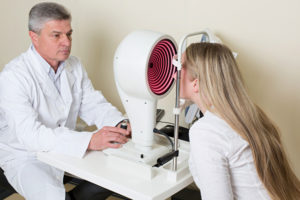Keratoconus is a serious vision-threatening condition where the front window of the eye (the cornea), slowly weakens and bulges outward into a cone-like shape rather than its normal spherical shape. Over time, this can lead to poor vision even with glasses or contacts, including contacts falling out of the eye frequently due to the irregular shaping of the cornea. Additionally, scarring of the cornea, and pain, and vision loss may occur. End-stage keratoconus may require a cornea transplant, a major surgery with significant risks during surgery and for the life of the patient.
Over the last few years, the management of keratoconus has evolved to include new treatments, including Intacs and crosslinking, which are some of the more common and accepted treatments currently. Intacs is a simple outpatient procedure that takes about 10 minutes to perform. This procedure involves placement of a small plastic ring in the eye to support the cornea and normalize its contour into a more spherical shape. Intacs often can help reduce the nearsightedness and/or astigmatism induced by keratoconus and enable younger patients to wear a soft contact lens. Older patients with cataracts and keratoconus to have a better outcome with this procedure after cataract surgery and be eligible for additional intraocular lens options.
While there are a wide range of treatment options available we are particularly proud to offer the AvaGen™ Eye Test.
AvaGen™ is the genetic eye test that provides answers on your risk for keratoconus and other corneal diseases—helping you and your doctor make confident eye care decisions now.
The one of a kind AvaGen™ test is:
- Personalized: Uses your DNA to assess your risk of keratoconus, and if you have a corneal dystrophy.
- Preemptive: Finds potential problems before symptoms occur which allows for proactive management and treatment.
- Painless: A sample is taken from the inside of your cheek with a cotton swab.
Check out what some of our patients have to say about their time and treatment with us.
